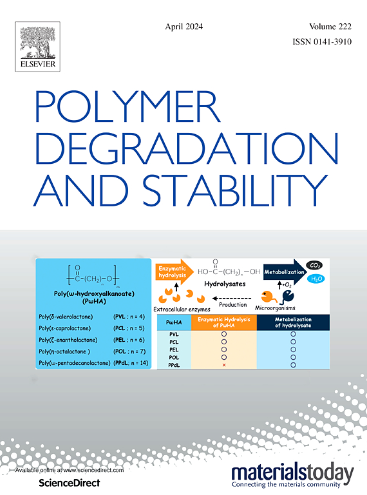Study on the structure–property relationship of starch/PLA composite films modified by the synergistic effect of aromatic rings and aliphatic chains
IF 7.4
2区 化学
Q1 POLYMER SCIENCE
引用次数: 0
Abstract
To investigate the synergistic effects of flexible aliphatic chains and rigid aromatic rings on the properties of polylactic acid (PLA)-based composites, a series of mono-esterified octanoyl starches (OC) and dual-esterified octanoyl–benzoyl starches (OC-BA) with comparable degrees of substitution (DS) were synthesized. The modified starches were blended with PLA at a 1:1 mass ratio, and composite films were prepared via solution casting. The results indicated that OC with a moderate DS (DS = 1.2) significantly improved the ductility of the films due to the introduction of flexible aliphatic chains. At a similar DS, the benzene rings in the PLA/OC-BA2 structure, in synergy with the fatty acid chains, enabled the composite film to reach a maximum elongation at break of 250.78%. Moreover, OC-BA2 promoted strong interfacial interactions with the PLA matrix through hydrogen bonding and π–π stacking, thereby enhancing both strength and toughness. Molecular docking simulations further elucidated the interfacial configurations and non-covalent interactions under different substitution patterns. In terms of biodegradability, the mono-esterified OC-based composites significantly accelerated the degradation rate of the films, whereas the dual-esterified OC-BA structure further improved the films’ aging resistance, hydrophobicity, and barrier properties. However, its biodegradability was markedly reduced, with the degradation rate of PLA/OC-BA2 being approximately 11.01%. Therefore, incorporating differently modified starches enables targeted regulation of the performance of PLA composite films to meet specific application requirements.
芳香环和脂肪链协同改性淀粉/聚乳酸复合膜的结构-性能关系研究
为了研究柔性脂肪链和刚性芳环对聚乳酸(PLA)基复合材料性能的协同作用,合成了一系列取代度相当的单酯化辛烷酰淀粉(OC)和双酯化辛烷酰苯甲酰淀粉(OC- ba)。将改性淀粉与聚乳酸以1:1的质量比共混,通过溶液浇铸法制备复合膜。结果表明,适度DS (DS = 1.2)的OC由于引入了柔性脂肪链而显著提高了薄膜的延展性。在类似的DS下,PLA/OC-BA2结构中的苯环与脂肪酸链协同作用,使复合膜的最大断裂伸长率达到250.78%。此外,OC-BA2通过氢键和π -π堆积促进了与PLA基体的强界面相互作用,从而提高了强度和韧性。分子对接模拟进一步阐明了不同取代模式下的界面构型和非共价相互作用。在生物降解性方面,单酯化oc基复合材料显著加快了膜的降解速度,而双酯化OC-BA结构进一步提高了膜的耐老化、疏水和屏障性能。但其生物降解性明显降低,PLA/OC-BA2的降解率约为11.01%。因此,加入不同的改性淀粉可以有针对性地调节PLA复合膜的性能,以满足特定的应用要求。
本文章由计算机程序翻译,如有差异,请以英文原文为准。
求助全文
约1分钟内获得全文
求助全文
来源期刊

Polymer Degradation and Stability
化学-高分子科学
CiteScore
10.10
自引率
10.20%
发文量
325
审稿时长
23 days
期刊介绍:
Polymer Degradation and Stability deals with the degradation reactions and their control which are a major preoccupation of practitioners of the many and diverse aspects of modern polymer technology.
Deteriorative reactions occur during processing, when polymers are subjected to heat, oxygen and mechanical stress, and during the useful life of the materials when oxygen and sunlight are the most important degradative agencies. In more specialised applications, degradation may be induced by high energy radiation, ozone, atmospheric pollutants, mechanical stress, biological action, hydrolysis and many other influences. The mechanisms of these reactions and stabilisation processes must be understood if the technology and application of polymers are to continue to advance. The reporting of investigations of this kind is therefore a major function of this journal.
However there are also new developments in polymer technology in which degradation processes find positive applications. For example, photodegradable plastics are now available, the recycling of polymeric products will become increasingly important, degradation and combustion studies are involved in the definition of the fire hazards which are associated with polymeric materials and the microelectronics industry is vitally dependent upon polymer degradation in the manufacture of its circuitry. Polymer properties may also be improved by processes like curing and grafting, the chemistry of which can be closely related to that which causes physical deterioration in other circumstances.
 求助内容:
求助内容: 应助结果提醒方式:
应助结果提醒方式:


